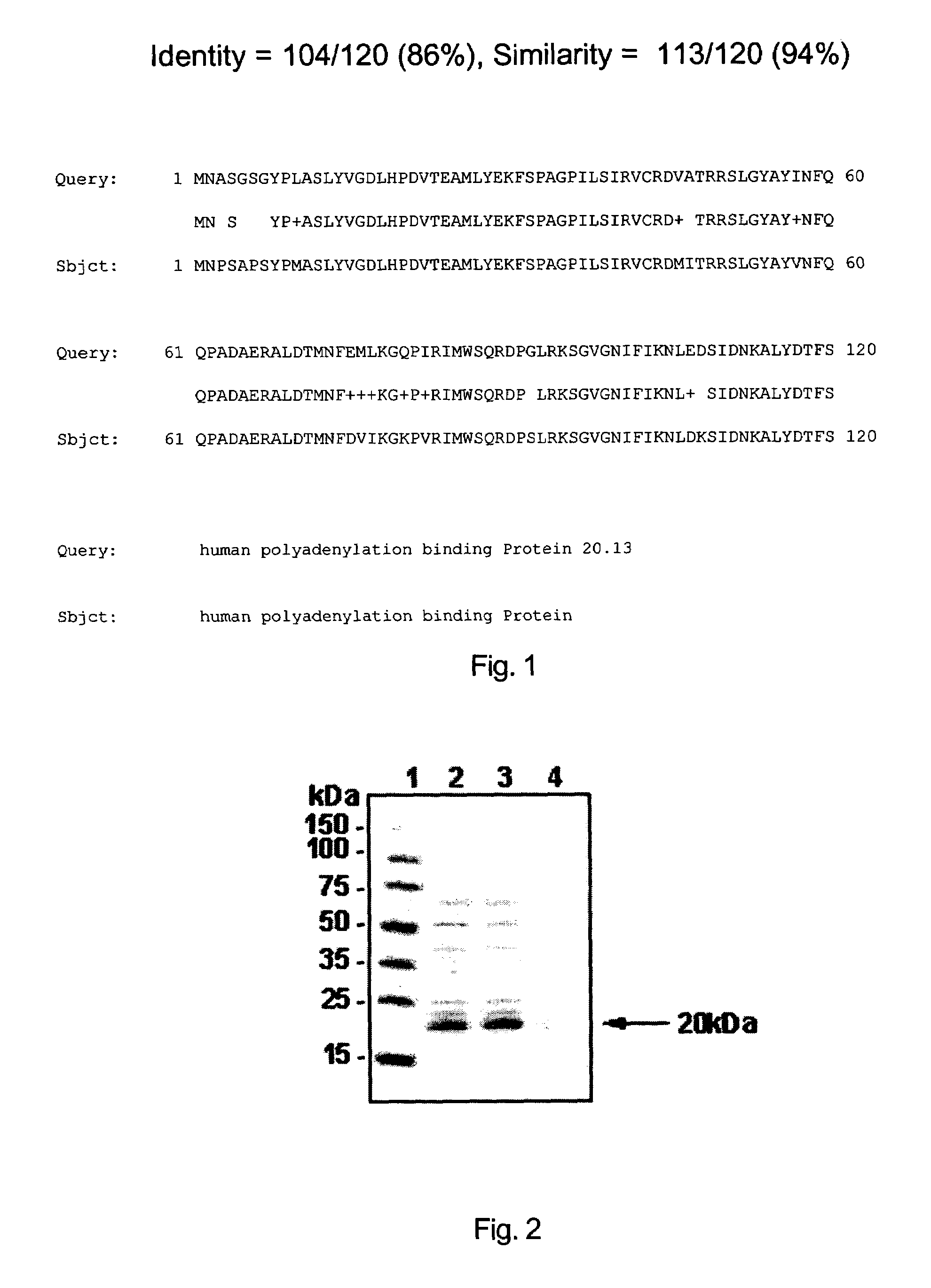Polypeptide human polyadenylation binding protein 20.13 and polynucleotide encoding it
a technology of human polyadenylation binding protein and polynucleotide sequence, applied in the field of biotechnology, can solve the problems of loss of translation regulation function and developmental abnormalities
- Summary
- Abstract
- Description
- Claims
- Application Information
AI Technical Summary
Benefits of technology
Problems solved by technology
Method used
Image
Examples
example 1
Cloning of Human Polyadenylation Binding Protein 20.13 Gene
[0118]Total RNA from a human embryonic brain was extracted by the one-step method with guanidinium isocyanate / phenol / chloroform. The poly (A) mRNA was isolated from the total RNA with Quik mRNA Isolation Kit (Qiegene). cDNA was prepared by reverse transcription with 2 μg poly (A) mRNA. The cDNA fragments were inserted into the polyclonal site of pBSK (+) vector (Clontech) using Smart cDNA cloning kit (Clontech) and then transformed into DH5α to form the cDNA library. The 5′- and 3′-ends of all clones were sequenced with Dye terminate cycle reaction sequencing kit (Perkin-Elmer) and ABI 377 Automatic Sequencer (Perkin-Elmer). The sequenced cDNA were compared with the public database of DNA sequences (Genebank) and the DNA sequence of one clone 2347g08 was found to be a novel DNA sequence. The inserted cDNA sequence of clone 2347g08 was dual-directionally sequenced with a serial of synthesized primers. It was indicated that th...
example 2
Homology Search of cDNA Clone
[0119]The homology research of the DNA sequence and its protein sequence of human polyadenylation binding Protein 20.13 of the invention were performed by Blast (Basic local Alignment search tool) (Altschul, et al., 1990, J. Mol. Biol.; 215:403–10) in databases such as Genbank, Swissport, etc. The most homologous gene to human polyadenylation binding Protein 20.13 of the invention is known human polyadenylation binding Protein. The Genbank accession number of its encoded protein is X65553. The alignment result of the protein was shown in FIG. 1. Two proteins are highly homologous with an identity of 86% and a similarity of 94%.
example 3
Cloning Human Polyadenylation Binding Protein 20.13 Gene by RT-PCR
[0120]The template was total RNA extracted from a human embryonic brain. The reverse transcription was carried out with oligo-dT primer to produce cDNAs. After cDNA purified with Qiagen Kit, PCR was carried out with the following primers:
[0121]
Primer 1:5′-GAGCCCCGGCCCCCTGCCCACCAT-3′(SEQ ID NO:3)Primer 2:5′-CATAGGCCGAGGCGGCCGACATGT-3′(SEQ ID NO:4)
[0122]Primer 1 is the forward sequence started from position 1 of 5′ end of SEQ ID NO: 1.
[0123]Primer 2 is the reverse sequence of the 3′ end of SEQ ID NO: 1.
[0124]The amplification condition was a 50 μl reaction system containing 50 mmol / L KCl, 10 mmol / L Tris-Cl (pH8.5), 1.5 mmol / L MgCl2, 200 μmol / L dNTP, 10 pmol of each primer, 1 U Taq DNA polymerase (Clontech). The reaction was performed on a PE 9600 DNA amplifier with the following parameters: 94° C. 30 sec, 55° C. 30 sec, and 72° C. 2 min for 25 cycles. β-actin was used as a positive control, and a blank template, as a ne...
PUM
| Property | Measurement | Unit |
|---|---|---|
| molecular weight | aaaaa | aaaaa |
| temperature | aaaaa | aaaaa |
| pH | aaaaa | aaaaa |
Abstract
Description
Claims
Application Information
 Login to View More
Login to View More - R&D
- Intellectual Property
- Life Sciences
- Materials
- Tech Scout
- Unparalleled Data Quality
- Higher Quality Content
- 60% Fewer Hallucinations
Browse by: Latest US Patents, China's latest patents, Technical Efficacy Thesaurus, Application Domain, Technology Topic, Popular Technical Reports.
© 2025 PatSnap. All rights reserved.Legal|Privacy policy|Modern Slavery Act Transparency Statement|Sitemap|About US| Contact US: help@patsnap.com


